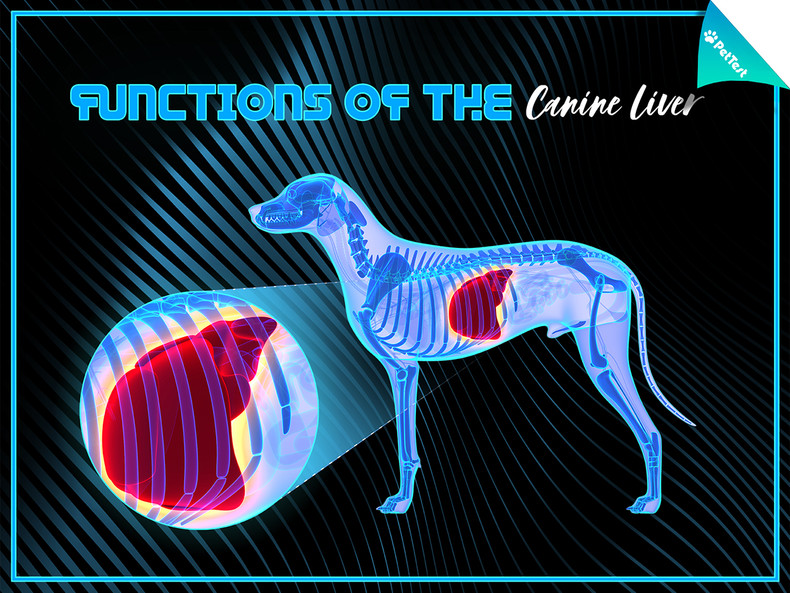Functions of the Canine Liver
Because our dogs are diabetic we talk about the pancreas at length due to it no longer functioning properly. But did you know that the liver produces glucose for energy? It makes sense to me to learn how both the liver and pancreas work. After all, glucose and insulin are why we are here reading and learning.
The liver does a lot and is an amazing organ, it is the only organ that can regenerate itself while supporting the body. Grab a cup of your favorite caffeinated beverage and let’s look at the functions of the liver.

A quick breakdown of functions of the liver:
- Produces bile.
- Activates enzymes.
- Detoxifies and purifies blood.
- Excretes bilirubin, cholesterol and hormones.
- Stores vitamins and minerals.
- Synthesizes plasma proteins and blood clotting proteins.
- Glycogenolysis.
- Gluconeogenesis.
- Ketogenesis.
The last three functions listed are what we are going to talk about further since they are a big part of diabetes.
Foods are broken down by the digestive system, starting with saliva in the mouth, saliva has an enzyme in it called salivary amylase. The gastrointestinal tract produces different enzymes that help break down food:
- Amylase – breaks down starches/carbs; produced in the salivary glands and the pancreas.
- Lipase – breaks down fats; produced in the pancreas, mouth, and stomach.
- Protease – breaks down proteins; produced in the stomach, pancreas and small intestine.
- Pepsin – helps break down proteins and is produced in the stomach lining.
A semi fluid called chyme is formed in the stomach, this consists of partially digested food and digestive juices. These digestive juices include pepsin and hydrochloric acid. When the chyme moves into the small intestine, the pancreas releases a high concentrated bicarbonate to neutralize the extremely acidic digestive juices. Once in the intestinal tract, the small intestine absorb nutrients, water and minerals. The nutrients; protein, fat fiber, carbs, water and minerals are then absorbed by the liver for further processing.
Glycogenolysis – the liver breaks down glycogen into glucose. Glucose is used as energy (food) for cells.
Gluconeogenesis – the liver metabolizes amino acids, fats and proteins into glucose for energy. This happens when there is not enough glycogen to produce glucose. If your dog is having a hypoglycemic episode, the liver kicks in as an emergency response, synthesizes amino acids, fat and protein for glucose. When too much insulin is given, this response of the liver can cause rebound / Somogyi Effect.
Ketogenesis – when insulin levels are low, the liver produces ketone bodies from fatty acids instead of producing glucose from glycogen. Ketones are then used to supply energy to the heart, brain and muscles. This is a dangerous process for a diabetic since ketone build up causes diabetic ketoacidosis (DKA).
Just like humans, dogs get liver disease. When there is liver disease, it can affect glucose output. We can see insulin resistance (high, uncontrolled blood glucose levels) due to glucose being dumped into the blood stream. We can also see hypoglycemia due to the liver not producing or releasing glucose.
Here are some liver illnesses/diseases:
Hepatitis – Hepatitis is inflammation of the liver. There are two types of hepatitis dogs can get; infectious hepatitis that is caused by a virus and chronic hepatitis. Chronic hepatitis is when the infection has caused necrosis. Copper storage disease can cause chronic hepatitis.
Liver cancer / tumors – Can cause hypoglycemia due to the liver not producing glucose from glycogen. Liver cancer / tumors can also cause hyperglycemia.
Portosystemic shunt (liver shunt) – Portal veins collect blood from the GI tract, pancreas and spleen and carries it into the liver. A “shunt” is formed and causes the blood to bypass the liver. Liver shunts are usually congenital.
Whether or not your dog has liver disease, detoxing the liver can help with blood glucose levels. It is a good idea to ensure that the liver is functioning properly since this organ does so much! Here is a link to my blog on Supplements for Diabetic Dogs: Part 2. There are several liver supplements listed that have been used.
I hope this latest blog has been informative and you have a better understanding of liver functions. If you have a question, comment or an addition please start a conversation below!
If you are looking for a Facebook community to join for support, I have been an admin in Diabetic Dog Owners for over four years. You can also join Canine Diabetes Support and Information on Facebook as well.
For more conversations, photos, and giveaways check out PetTest on Facebook and Instagram.

